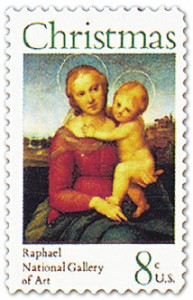The design of the 1973 Christmas stamps by Dolli Tingle, which features a whimsical old-fashioned Christmas tree, was the first U.S. stamp ever designed in needlepoint. (The 1964 Homemaker’s commemorative stamp was designed by Norman Todhunter to simulate the needlework of an early American sampler, but the design was not actually executed in needlepoint.)
The second Christmas stamp was adapted from a Madonna and child painted by Raphael, a major Italian artist of the Renaissance. The painting hangs in the National Gallery of Art in Washington. The Madonna stamp was designed by Bradbury Thompson.
The two 8-cent stamps were issued on November 7 at Washington, D.C., with ceremonies at the National Gallery of Art. It is Postal Service policy to issue two stamps each year so that holiday mailers may have a choice.
The vertical, commemorative-size stamps will be printed on the Andreotti gravure press in six colours. Yellow, light brown, red, blue, black and green inks will reproduce the Raphael art. Light brown, yellow, gold, red, blue and black inks will print the needlepoint Christmas tree. Each stamp will have six plate numbers.
“U.S. 8c” in black, appears at the top of the needlepoint stamp, with “Christmas”, in red at the bottom. “Christmas” in green, appears at the top of the Madonna and Child stamp. At the bottom, in black, is “Raphael, National Gallery of Art, U.S.” “8c” is in green.
Artists usually paint stamp designs – but not always. The Science commemorative stamp of 1963 was a wood engraving by Antonio Frasconi. So was Walter Brooks’ San Juan stamp of 1971. Last year’s Olympic designs were collages by Lance Wyman.
Now Dolli Tingle turned out a design in needlepoint. This took her about ten days. The daughter of an artist, she is also married to one Ward Brackett, who designed the Girl Scout, Law and Order and Suffrage stamps. She studied at the Chicago Academy of Fine Arts.
Raphael’s painting “The Small Cowper Madonna” bears this title because its first recorded owner was Lord Cowper, British Ambassador to the Court of Tuscany. Cowper owned a larger Raphael Madonna also, hence the “small” in the title.
He bought it in 1780. Raphael painted it, in Florence, about 1505, when the artist was in his early 20s. It is on wood and measures 23 ins. in height and 17 ins. in width. Art critics see evidences of the influence of both Michelangelo and Leonardo da Vinci in the painting, with their styles subtly merged by Raphael.









i have both of the above stamps (used) are they worth anything??